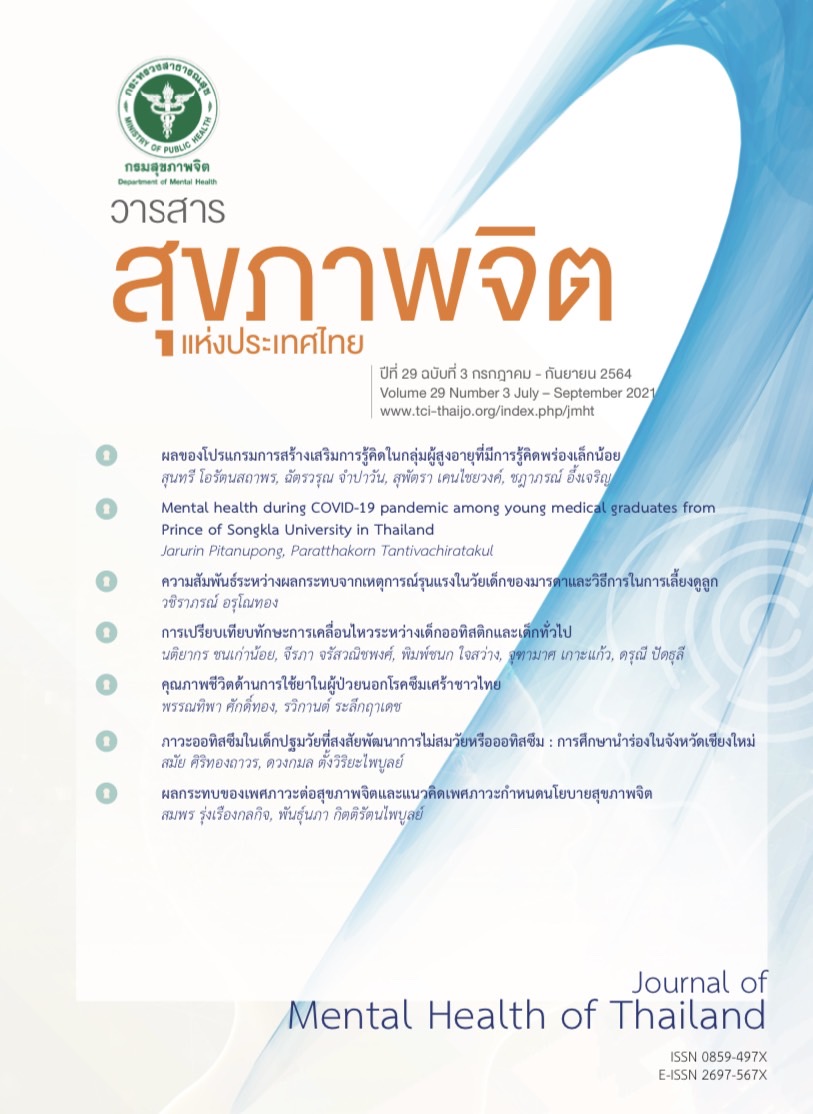คุณภาพชีวิตด้านการใช้ยาในผู้ป่วยนอกโรคซึมเศร้าชาวไทย
คำสำคัญ:
คุณภาพชีวิต, ยารักษาโรคซึมเศร้า, โรคซึมเศร้าบทคัดย่อ
วัตถุประสงค์ : เพื่อประเมินคุณภาพชีวิตด้านการใช้ยา และหาความสัมพันธ์ระหว่างคุณภาพชีวิตด้านการใช้ยากับตัวแปรด้านประชากรและด้านคลินิกของผู้ป่วยโรคซึมเศร้า
วิธีการ : ผู้ป่วยนอกโรคซึมเศร้าที่โรงพยาบาลศรีธัญญา จำนวน 138 คน ได้รับการเลือกแบบเจาะจง ระหว่างเดือนเมษายน พ.ศ. 2561 ถึงมีนาคม พ.ศ. 2562 ประเมินคุณภาพชีวิตด้านการใช้ยาด้วยเครื่องมือ Patient-Reported Outcomes Measure of Pharmaceutical Therapy (PROMPT) ประกอบด้วย 16 ข้อ 8 มิติ ได้แก่ การได้รับข้อมูลยาและโรค ความพึงพอใจต่อประสิทธิผลของยา ผลกระทบของการใช้ยาและอาการข้างเคียง ผลกระทบทางจิตใจของการใช้ยา ความสะดวกของการใช้ยา การมียาให้ใช้และการเข้าถึงการใช้ยา ความสัมพันธ์ทางการรักษา และคุณภาพชีวิตการใช้ยาโดยรวม วิเคราะห์ถดถอยเชิงเส้นแบบพหุตัวแปรเพื่อหาปัจจัยที่ทำนายคุณภาพชีวิตด้านการใช้ยา
ผล : ค่าเฉลี่ยคะแนนมิติของคุณภาพชีวิตการใช้ยาอยู่ระหว่าง 58 - 80 คะแนน (ระดับปานกลางถึงดีเลิศ) มิติที่ได้คะแนนต่ำสุดและสูงสุด ได้แก่ การได้รับข้อมูลยาและโรค และการมียาให้ใช้และการเข้าถึงการใช้ยา ตามลำดับ ผู้ป่วยอายุน้อย เพศหญิง มีระดับการศึกษาต่ำ มีภาระทางการเงิน ใช้ยาจำนวนมาก มีอาการข้างเคียงจากยา และมีการควบคุมโรคที่ไม่ดี สัมพันธ์กับคุณภาพชีวิตการใช้ยาที่ไม่ดีอย่างมีนัยสำคัญทางสถิติ
สรุป : บุคลากรทางการแพทย์ควรให้ข้อมูลยาและโรคแก่ผู้ป่วย และให้ความสำคัญกับปัจจัยที่มีผลต่อคุณภาพชีวิตด้านการใช้ยา เช่น ภาระทางการเงิน จำนวนยาที่ใช้ต่อวัน อาการข้างเคียงจากยา และการควบคุมโรคของผู้ป่วย
Downloads
เอกสารอ้างอิง
World Health Organization. Depression and other common mental disorders: global health estimates. Geneva; 2017.
พันธุ์นภา กิตติรัตนไพบูลย์, นพพร ตันติรังสี, วรวรรณ จุฑา, อธิบ ตันอารีย์, ปทานนท์ ขวัญสนิท, สาวิตรี อัษณางค์กรชัย, และคณะ. ความชุกของโรคจิตเวชและปัญหาสุขภาพจิต : การสำรวจระบาดวิทยาสุขภาพจิตของคนไทยระดับชาติ ปี พ.ศ. 2556 [Prevalence of mental disorders and mental health problems: results from Thai national mental health survey 2013]. นนทบุรี: สำนักบริหารระบบบริการสุขภาพจิต กรมสุขภาพจิต; 2559.
Teter CJ, Kando JC, Wells BG. Major depressive disorder. In: Dipiro JT, Talbert RL, Yee GC, Matzke GR, Wells BG, et al, editors. Pharmacotherapy: a pathophysiologic approach. 8th ed. New York: McGraw-Hill; 2011. p. 1173-239.
Fortney JC, Pyne JM, Edlund MJ, Stecker T, Mittal D, Robinson DE, et al. Reasons for antidepressant nonadherence among veterans treated in primary care clinics. J Clin Psychiatry. 2011;72(6):827-34. doi:10.4088/JCP.09m05528blu.
Zolnoori M, Fung KW, Fontelo P, Kharrazi H, Faiola A, Wu YSS, et al. Identifying the underlying factors associated with patients’ attitudes toward antidepressants: qualitative and quantitative analysis of patient drug reviews. JMIR Ment Health. 2018;5(4):e10726. doi:10.2196/10726.
Eveleigh R, Speckens A, van Weel C, Voshaar RO, Lucassen P. Patients’ attitudes to discontinuing not-indicated long-term antidepressant use: barriers and facilitators. Ther Adv Psychopharmacol. 2019;9:1-9. doi:10.1177/2045125319872344.
Maund E, Dewar-Haggart R, Williams S, Bowers H, Geraghty AWA, Leydon G, et al. Barriers and facilitators to discontinuing antidepressant use: A systematic review and thematic synthesis. J Affect Disord. 2019;245:38–62. doi:10.1016/j.jad.2018.10.107.
Montejo AL, Montejo L, Navarro-Cremades F. Sexual side-effects of antidepressant and antipsychotic drugs. Curr Opin Psychiatry. 2015;28(6):418–23. doi:10.1097/YCO.0000000000000198.
Sakthong P, Sonsa‑ardjit N, Sukarnjanaset P, Munpan W, Sangthonganotai T. Development and psychometrics of a short‑form pharmaceutical care‑specific measure for quality of life. Int J Clin Pharm. 2018;40(3):642-9. doi:10.1007/s11096-018-0638-4.
Sakthong P, Suksanga P, Sakulbumrungsil R, Winit-Watjana W. Development of patient-reported outcomes measure of pharmaceutical therapy for quality of life (PROMPT-QoL): a novel instrument for medication management. Res Soc Admin Pharm. 2015;11(3):315-38. doi:10.1016/j.sapharm.2014.10.002.
Cipolle RJ, Strand LM, Morley PC. Pharmaceutical care practice: the clinician’s guide. 2nd ed. New York: McGraw-Hill; 2004.
Sakthong P, Chinthammit C, Sukarnjanaset P, Sonsa-ardjit N, Munpan W. Psychometric properties of the patient-reported outcomes measure of pharmaceutical therapy for quality of life (PR.OMPT-QoL). Value Health Reg Issues. 2017;12:41-9. doi:10.1016/j.vhri.2017.02.003.
Nunnally JC, editors. Psychometric Theory. 2nd ed. New York: McGraw-Hill; 1978.
Neter J, Kutner MH, Nachtsheim CJ, Wasserman W. Applied Linear Statistical Models. 4th ed. New York: McGrow-Hill; 1996.
Yen CF, Chen CC, Lee Y, Tang TC, Ko CH, Yen JY. Association between quality of life and self-stigma, insight, and adverse effects of medication in patients with depressive disorders. Depress Anxiety. 2009;26(11):1033–9. doi:10.1002/da.20413.
ดาวน์โหลด
เผยแพร่แล้ว
รูปแบบการอ้างอิง
ฉบับ
ประเภทบทความ
สัญญาอนุญาต
- ผู้อ่านสามารถนำข้อความ ข้อมูล จากวารสารไปใช้ไปใช้ประโยชน์ทางวิชาการได้ เช่น เพื่อการสอน เพื่อการอ้างอิง แต่การนำไปใช้เพื่อวัตถุประสงค์อื่น เช่น เพื่อการค้า จะต้องได้รับอนุญาตเป็นลายลักษณ์อักษรจากกรมสุขภาพจิตก่อน
- ความคิดเห็น ข้อมูล และบทสรุปต่าง ๆ ที่ลงตีพิมพ์ในวารสารสุขภาพจิตแห่งประเทศไทยเป็นของผู้เขียนบทความและมิได้แสดงว่ากองบรรณาธิการหรือกรมสุขภาพจิตเห็นพ้องด้วย




